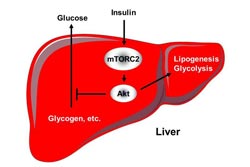Growth Regulator mTORC2 Linked to Diabetes

Model for the role of mTORC2 in the regulation of the glucose metabolism in the liver. University of Basel, Biozentrum<br>
In the current issue of the journal «Cell Metabolism», Mike Hall and his team from the Biozentrum of the University of Basel describe how inhibition of mTOR signaling can impair carbohydrate metabolism and potentially lead to diabetes.
The protein mTOR regulates both cell growth and metabolism and thus plays a key role in the development of many disorders. In the cell, this regulatory protein is found in two structurally and functionally distinct multiprotein complexes called mTORC1 and mTORC2. mTORC2 is less well studied than mTORC1.
After the research group of Mike Hall from the Biozentrum of the University of Basel recently demonstrated how mTORC2 is activated in tumor cells, a new investigation by the same team has shed light on the role of mTORC2 in carbohydrate metabolism and in the development of diabetes.
Diabetes due to mTORC2 deficiency
In the healthy organism, insulin regulates blood glucose levels and activates the mTORC2 signaling pathway. Upon genetic inactivation of mTORC2 in the liver, blood glucose and insulin levels were elevated as soon as a few weeks after birth. In addition, the loss of mTORC2 led to insulin resistance. Consequently, liver cells could no longer respond to nutrients supplied via the diet and continued to produce new carbohydrates despite rising blood glucose levels.
The scientists also demonstrated how insulin resistance, originally affecting only the liver, spread to the whole body with the increasing age of the animals. The mice developed the typical symptoms of type 2 diabetes. The cell biologist Dr. Marion Cornu commented, “We were excited to see that the inhibition of mTORC2 in the liver caused an imbalance in carbohydrate metabolism not only in the liver but also in the the whole organism. This told us that mTORC2 in the liver controls metabolism of the whole body.”
Cancer treatment with side effects
mTOR inhibitors currently being developed for use against tumor growth usually inhibit both mTOR complexes. Through the use of newer, more specific mTORC2 inhibitors doctors hope to be able to prevent uncontrolled growth of tumor cells without affecting healthy cells. The new findings of Hall and his team provide evidence that such cancer treatments must take into account the development of diabetes as a possible side effect.
Original article
Asami Hagiwara, Marion Cornu, Nadine Cybulski, Pazit Polak, Charles Betz, Francesca Trapani, Luigi Terracciano, Markus H. Heim, Markus A. Rüegg, Michael N. Hall
Hepatic mTORC2 Activates Glycolysis and Lipogenesis through Akt, Glucokinase, and SREBP1c
Cell Metabolism, Volume 15, Issue 5, 725-738, 19 April 2012 | doi: 10.1016/j.cmet.2012.03.015
Media Contact
Prof. Dr. Michael N. Hall, Biozentrum of the University of Basel, Tel: +41 61 267 21 50, E-mail: m.hall@unibas.ch
Media Contact
All latest news from the category: Life Sciences and Chemistry
Articles and reports from the Life Sciences and chemistry area deal with applied and basic research into modern biology, chemistry and human medicine.
Valuable information can be found on a range of life sciences fields including bacteriology, biochemistry, bionics, bioinformatics, biophysics, biotechnology, genetics, geobotany, human biology, marine biology, microbiology, molecular biology, cellular biology, zoology, bioinorganic chemistry, microchemistry and environmental chemistry.
Newest articles

Superradiant atoms could push the boundaries of how precisely time can be measured
Superradiant atoms can help us measure time more precisely than ever. In a new study, researchers from the University of Copenhagen present a new method for measuring the time interval,…

Ion thermoelectric conversion devices for near room temperature
The electrode sheet of the thermoelectric device consists of ionic hydrogel, which is sandwiched between the electrodes to form, and the Prussian blue on the electrode undergoes a redox reaction…

Zap Energy achieves 37-million-degree temperatures in a compact device
New publication reports record electron temperatures for a small-scale, sheared-flow-stabilized Z-pinch fusion device. In the nine decades since humans first produced fusion reactions, only a few fusion technologies have demonstrated…





















